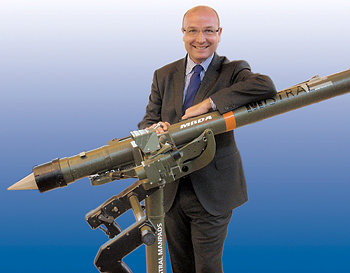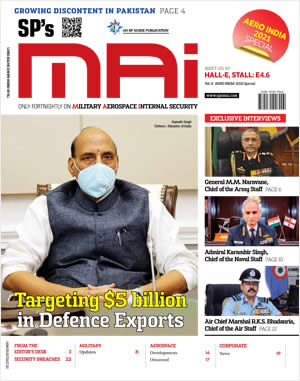INDIAN ARMED FORCES CHIEFS ON OUR RELENTLESS AND FOCUSED PUBLISHING EFFORTS

The insightful articles, inspiring narrations and analytical perspectives presented by the Editorial Team, establish an alluring connect with the reader. My compliments and best wishes to SP Guide Publications.

"Over the past 60 years, the growth of SP Guide Publications has mirrored the rising stature of Indian Navy. Its well-researched and informative magazines on Defence and Aerospace sector have served to shape an educated opinion of our military personnel, policy makers and the public alike. I wish SP's Publication team continued success, fair winds and following seas in all future endeavour!"

Since, its inception in 1964, SP Guide Publications has consistently demonstrated commitment to high-quality journalism in the aerospace and defence sectors, earning a well-deserved reputation as Asia's largest media house in this domain. I wish SP Guide Publications continued success in its pursuit of excellence.
- Indian Air Force Aims for Full Indigenous Inventory by 2047 — Air Chief Marshal A.P. Singh
- General Upendra Dwivedi takes over as the Chief of the Army Staff
- Rajnath Singh assumes charge as Defence Minister for the second consecutive term
- Admiral Dinesh K. Tripathi assumes Command of the Indian Navy as 26th Chief of the Naval Staff
- Prime Minister witnesses 'Bharat Shakti' – a Tri-Services Firing and Manoeuvre Exercise in Pokhran, Rajasthan
MBDA keen on in-depth partnership with India

By Loïc Piedevache, Country Head, India, MBDA
India’s status as the subcontinent’s largest land mass, combined with its strategic location between the major economic and military focal points in the geopolitical divide between present and rapidly emerging great powers, has given rise to the country’s key role in developing global affairs. Although its economy faced a slowdown in the last couple of years, India’s growth since the turn of the century has been unprecedented and has contributed towards India becoming one of the world’s major military spenders, a fact concomitant with its leading status on the global stage. As for any nation, and perhaps more so for India given current issues in the region, efficient defence spending is critical to ensure that its armed forces are suitably equipped. India, as major player in the world of nations, needs to ensure that it more than keeps pace with military defence technology developments in its zones of interest, especially in the South Asia region. It is no secret that elements of India’s defence resources are in need of a major overhaul, though programmes such as the Mirage and Jaguar bomber aircraft upgrades and the much discussed medium multi-role combat aircraft (MMRCA) replacement for the ageing Indian Air Force (IAF) fleet of MiG-21s are signs that significant progress is being made. Indeed the decision to order 126 Rafale combat aircraft will provide the IAF with a capability, hopefully sooner rather than later, which will position the IAF among the leading air forces of the world.
The Rafale is a world leading aircraft but of course it is only as effective as the weapons it is capable of delivering. Fortunately, the aircraft is linked with MBDA’s suite of short, medium, beyond visual range and precision air-to-ground guided weapons that will allow it to fulfill the full range of roles covering interdiction, air superiority and strike. A modern mantra regarding weapon systems is that they must be selective, proportionate and of course, highly accurate. These are all features of MBDA weapon systems such as those associated with the Rafale including MICA (already ordered for the IAF’s Mirage upgrade) which is the only missile in the world featuring two interoperable seekers (active radar and imaging infrared) to cover the spectrum from close-in dogfight to long beyond visual range, Meteor which with its unmatched No Escape Zone is the most advanced of all BVRAAM weapons current or planned and of course Storm Shadow /SCALP which has proven its long-range high precision under extreme combat conditions in two theatres of war. With MBDA’s ASRAAM short to approaching BVR missile down selected for the IAF’s Jaguar upgrade, India has the potential of being equipped with the most capable air-launched missiles available.
Of course, this potential capability only remains hypothetical (while the threat remains a real one) until final decisions have been made and contracts have been signed. In addition, and in terms of fully protecting India’s airspace, air superiority will never provide a total guarantee against the diverse range of modern airborne threats that India and other countries need to prepare for. In this respect, the duty of care towards deployed forces, military and civilian centres and the effectiveness of military operations are always going to be at risk without comprehensive Ground Based Air Defence (GBAD). What is needed is an effective method of tracking, evaluating, identifying and ultimately responding to the threat with the appropriate air defence weapon or weapons. It also needs to be realised that effective GBAD is not possible with a single system. It will only be achieved through the correct configuration of a range of missile systems, that are selective, proportionate and provide a layered mix of capabilities.
The medium range Akash is in service and the Indian AAD (Advanced Air Defence) programme should lead in due course to a long-range ballistic missile interceptor. However, to provide the aforementioned layered defence it is important that India advances the short range and very short range elements of the overall network. That is why it is important that the much talked about SRSAM (MAITRI) programme gets a go ahead as well as the VSHORAD requirement which has been the subject of international competition.
SRSAM has seen MBDA supporting the Defence Research and Development Organisation (DRDO) with its far-reaching experience in GBAD technology offering extremely advanced levels of technology transfer. The importance of this system, that would be fully produced in India, lies not only in its ability to provide an important indigenous capability regarding India’s layered defence requirements, it will also advance the technological capability of Indian industry in a product that also has significant export potential. Regarding VSHORAD, this is also important regarding both capability and industrial issues. MBDA’s all-weather fire-and-forget Mistral MANPADS that is being offered, not only best meets the criteria laid out in the RFP but from the industrial side it also offers India transfer of technology in a possible in-country manufacture under licence agreement.
MBDA of course accepts that if it is to develop its in-depth partnership with India’s defence sector, at government, end-user and industrial levels, it has to accept local decision making procedures which can at times be drawn out. Recent changes to the direct offset policy have certainly helped non-Indian OEMs like MBDA to advance projects. A change in foreign direct investment (FDI), starting from 49 per cent or above, would also be a great boon to future investment plans. These will in turn serve to ensure that India gets access to the very best available air defence technology to secure its airspace, sovereign territory and the level of indigenous technology capability that a country of India’s stature merits.





